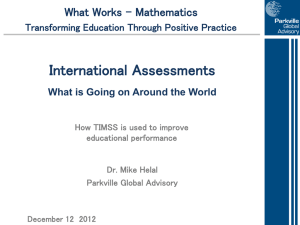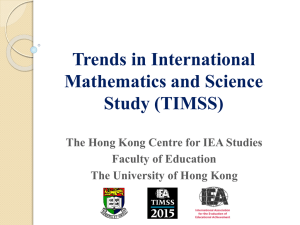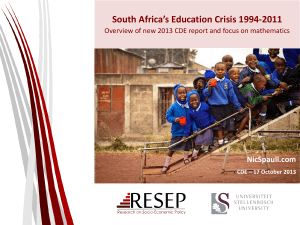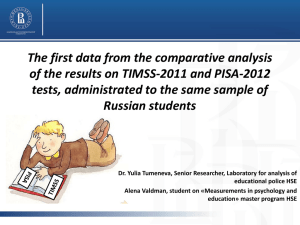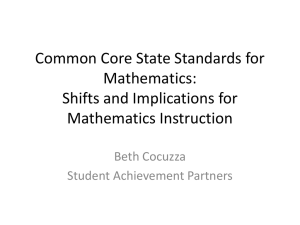TIMSS PowerPoint presentation - Florida Department of Education
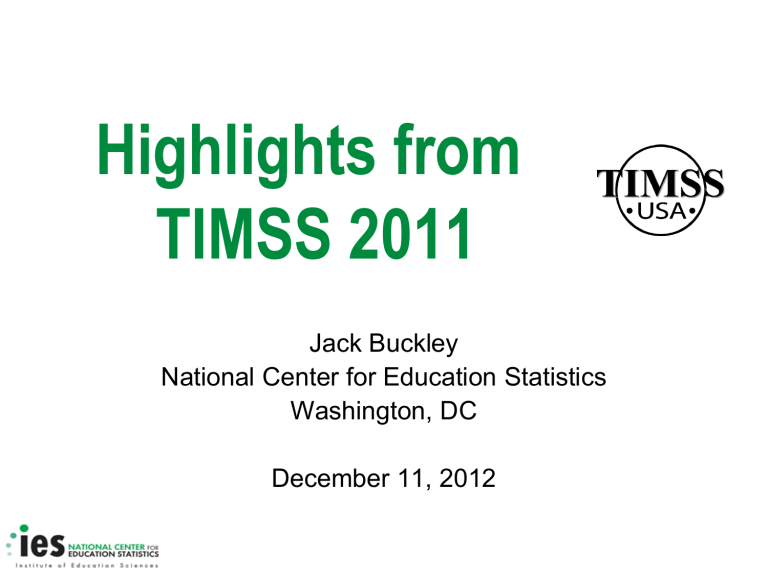
Highlights from
TIMSS 2011
Jack Buckley
National Center for Education Statistics
Washington, DC
December 11, 2012
Overview
What is TIMSS and which education systems participate?
How are U.S. students performing compared to their international peers in:
4th- and 8th-grade mathematics?
4th- and 8th-grade science?
How are students performing in participating U.S. states?
2
What is TIMSS?
• Trends in International Mathematics and Science Study
(TIMSS)
• 4th- and 8th-grade mathematics and science assessment
• Developed by the TIMSS & PIRLS International Study
Center at Boston College, under contract to the
International Association for the Evaluation of Educational
Achievement (IEA)
* In 1999, no grade 4 assessment. 3
2011
4
TIMSS Participating States
•
9 states participated as separate entities to obtain scores in TIMSS
TIMSS grade 4
Florida
North Carolina
TIMSS grade 8
Florida
North Carolina
Alabama
California
Colorado
Connecticut
Indiana
Massachusetts
Minnesota
•
States participated as part of the nation and as their own entity
•
NCES funded participation at grade 8 of all states except Florida as part of a study to statistically link NAEP (National Assessment of
Educational Progress) and TIMSS. Florida used Race to the Top funds to fund participation in TIMSS at grades 4 and 8.
5
U.S. TIMSS national and state sample sizes
4th grade
Schools: 369
Students: 12,569
8th grade
Schools: 501
Students: 10,477
4th grade
(FL, NC)
Schools: 46 – 77
Students:
1,792
– 2,661
8th grade
(AL, CA, CO, CT, FL, IN, MA, MN, NC)
Schools: 53 – 82
Students:
1,712 – 2,614
6
MATHEMATICS
TIMSS 2011 Mathematics Framework
Content dimensions
Cognitive dimensions
TIMSS Mathematics
Grade 4
Number
Geometric Shapes and Measures
Data Display
Grade 8
Number
Algebra
Geometry
Data and Chance
Knowing
Applying
Reasoning
8
G
R
A
D
E
4
What is on the TIMSS mathematics assessment?
Percentage of 4thgraders answering correctly:
U.S.: 76%
Int’l Avg.: 65%
9
A
A
D
D
G
G
R
R
E
E
8
8
What is on the TIMSS mathematics assessment?
Percentage of 8thgraders answering correctly:
U.S.: 87%
Int’l Avg.: 70%
10
U.S. average score (541) higher than the TIMSS scale average (500)
Higher than U.S.
Not measurably different than U.S.
Lower than U.S.
11
U.S. average score (509) higher than the TIMSS scale average (500)
Higher than U.S.
Not measurably different than U.S.
Lower than U.S.
12
Average mathematics scores of 4th-grade students from 2007 to 2011 in 12 education systems, including the U.S.
Chinese Taipei-CHN
Japan
UNITED STATES
Denmark
Quebec-CAN
Slovenia
Czech Republic
Norway
Dubai-UAE
Georgia
Iran, Islamic Rep. of
Tunisia
12*
11*
12*
15*
14*
14*
17*
22*
24*
24*
28*
-20 -10 0 10 20 30
Change in average score
* p < .05. Change in average scores is significant.
NOTE: Education systems ordered according to average mathematics score in 2011.
32*
40
13
Average mathematics scores of 8th-grade students from 2007 to 2011 in 10 education systems
Korea, Rep. of
Singapore
Chinese Taipei-CHN
Russian Federation
UNITED STATES
Italy
Ukraine
Dubai-UAE
Georgia
Bahrain
Palestinian Nat'l Auth
1
11*
11*
16*
18*
17*
17*
19*
22*
27*
-20 -10 0 10
Change in average score
20 30
* p < .05. Change in average scores is significant.
NOTE: Education systems ordered according to average mathematics score in 2011.
37*
40
14
Average mathematics scores of 8th-grade students from 2007 to 2011 in 6 education systems
Hungary -12*
Sweden -7*
Malaysia
Thailand
Jordan
Syrian Arab Republic
-40
-34*
-14*
-21*
-15*
-30 -20 -10
Change in average score
0
* p < .05. Change in average scores is significant.
NOTE: Education systems ordered according to average mathematics score in 2011.
10 20
15
TIMSS international mathematics benchmarks
Grade 4
Advanced (625) Students can apply their understanding and knowledge in a variety of relatively complex situations and explain their reasoning.
High (550)
Intermediate
(475)
Students can apply their knowledge and understanding to solve problems.
Students can apply basic mathematical knowledge in straightforward situations.
Low (400) Students have some basic mathematical knowledge.
Grade 8
Students can reason with information, draw conclusions, make generalizations, and solve linear equations.
Students can apply their understanding and knowledge in a variety of relatively complex situations.
Students can apply basic mathematical knowledge in straightforward situations.
Students have some knowledge of whole numbers and decimals, operations, and basic graphs.
16
Percentages of U.S. 4th-graders reaching
TIMSS mathematics benchmarks were higher than international medians in 2011
NOTE: All U.S. percentages are significantly higher than the corresponding TIMSS international median at the .05 level of statistical significance.
17
Seven systems had higher percentages of 4thgrade students reaching Advanced than the U.S.
Higher than U.S. ( p < .05)
Not measurably different than U.S. ( p < .05)
NOTE: Education systems with lower percentages of students reaching the Advanced benchmark than the percentage of U.S. students reaching the Advanced benchmark are not included in figure.
18
Percentages of U.S. 8th-graders reaching
TIMSS mathematics benchmarks were higher than international medians in 2011
NOTE: All U.S. percentages are significantly higher than the corresponding TIMSS international median at the .05 level of statistical significance.
19
Eleven systems had higher percentages of 8thgraders reaching Advanced than the U.S.
Higher than U.S. ( p < .05)
Not measurably different than U.S. ( p < .05)
NOTE: Education systems with lower percentages of students reaching the Advanced benchmark than the percentage of U.S. students reaching the Advanced benchmark are not included in figure.
20
SCIENCE
TIMSS 2011 Science Framework
TIMSS Science
Content dimensions Grade 4
Earth science
Life science
Physical science
Cognitive dimensions
Grade 8
Biology
Chemistry
Earth science
Physics
Knowing
Applying
Reasoning
22
G
R
A
D
E
4
What is on the TIMSS science assessment?
Percentage of 4thgraders answering correctly:
U.S.: 90%
Int’l Avg.: 73%
23
G
R
A
D
E
8
What is on the TIMSS science assessment?
Percentage of 8thgraders answering correctly:
U.S.: 76%
Int’l Avg.: 61%
24
U.S. average score (544) higher than the TIMSS scale average (500)
Higher than U.S.
Not measurably different than U.S.
Lower than U.S.
25
U.S. average score (525) higher than the TIMSS scale average (500)
Higher than U.S.
Not measurably different than U.S.
Lower than U.S.
26
Average science scores of 4th-grade students from 2007 to 2011 in 9 education systems
11* Japan
UNITED STATES
Czech Republic
Sweden
Netherlands
Denmark
Norway
Georgia
Iran, Islamic Rep. of
Tunisia
-20 -10 0
5
8*
9*
11*
10
Change in average score
17*
17*
20
21*
27*
30
* p < .05. Change in average scores is significant.
NOTE: Education systems ordered according to average science score in 2011.
37*
40
27
Average science scores of 4th-grade students from 2007 to 2011 in 5 education systems
Hong Kong-CHN
England-GBR
Italy
Australia
New Zealand
-30
-19*
-20
-13*
-11*
-12*
-7*
-10 0
Change in average score
10
* p < .05. Change in average scores is significant.
NOTE: Education systems ordered according to average science score in 2011.
20 30
28
Singapore
Korea, Rep. of
Minnesota-USA
Russian Federation
UNITED STATES
Quebec-CAN
Ukraine
Norway
Iran, Islamic Rep. of
Palestinian Nat'l Auth
-20
Average science scores of 8th-grade students from 2007 to 2011 in 9 education systems
23*
-10 0
7*
15*
13*
5
13*
16*
8*
10
Change in average score
15*
16*
20 30
* p < .05. Change in average scores is significant.
NOTE: Education systems ordered according to average science score in 2011.
40
29
Average science scores of 8th-grade students from 2007 to 2011 in 7 education systems
Hungary
Bahrain
Thailand
Jordan
Malaysia
Syrian Arab Republic
Indonesia
-50
-44*
-40
-33*
-20*
-17*
-15*
-30
-26*
-21*
-20
Change in average score
-10
* p < .05. Change in average scores is significant.
NOTE: Education systems ordered according to average science score in 2011.
0 10
30
TIMSS international science benchmarks
Grade 4
Advanced (625) Students can apply knowledge and understanding of scientific processes and relationships and show some knowledge of the process of scientific inquiry.
High (550)
Intermediate
(475)
Low (400)
Students apply their knowledge and understanding of the sciences to explain phenomena in everyday and abstract contexts.
Students have basic knowledge and understanding of practical situations in the sciences.
Students have some elementary knowledge of life science and physical science.
Grade 8
Students communicate an understanding of complex and abstract concepts in biology, chemistry, physics, and earth science.
Students demonstrate understanding of concepts related to science cycles, systems, and principles.
Students recognize and apply their understanding of basic scientific knowledge in various contexts.
Students can recognize some basic facts from the life and physical sciences.
31
Percentages of U.S. 4th-graders reaching
TIMSS science benchmarks were higher than international medians in 2011
NOTE: All U.S. percentages are significantly higher than the corresponding TIMSS international median at the .05 level of statistical significance.
32
Three systems had higher percentages of 4thgrade students reaching Advanced than the U.S.
Higher than U.S. ( p < .05)
Not measurably different than U.S. ( p < .05)
NOTE: Education systems with lower percentages of students reaching the Advanced benchmark than the percentage of U.S. students reaching the Advanced benchmark are not included in figure.
33
Percentages of U.S. 8th-graders reaching
TIMSS science benchmarks were higher than international medians in 2011
NOTE: All U.S. percentages are significantly higher than the corresponding TIMSS international median at the .05 level of statistical significance.
34
Twelve systems had higher percentages of 8thgraders reaching Advanced than the U.S.
Higher than U.S. ( p < .05)
Not measurably different than U.S. ( p < .05)
NOTE: Education systems with lower percentages of students reaching the Advanced benchmark than the percentage of U.S. students reaching the Advanced benchmark are not included in figure.
35
Summary of change in average U.S. scores over time
Grade 4 TIMSS
Mathematics
2007-2011
TIMSS
Science
2007-2011
Grade 8 TIMSS
Mathematics
2007-2011
TIMSS
Science
2007-2011
Change over time in U.S. average scores was statistically significant.
Change over time in U.S. average scores was not measurably different.
36
For more information
TIMSS at NCES: http://nces.ed.gov/timss/
International Data Explorer: http://nces.ed.gov/timss/idetimss/
Contact:
Stephen Provasnik
NCES
Stephen.Provasnik@ed.gov
202-502-7480
37
